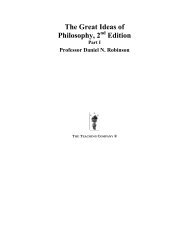English idioms in the first language and second language lexicon: a ...
English idioms in the first language and second language lexicon: a ...
English idioms in the first language and second language lexicon: a ...
You also want an ePaper? Increase the reach of your titles
YUMPU automatically turns print PDFs into web optimized ePapers that Google loves.
Beate Abel 333compositional, whereas nondecomposable <strong>idioms</strong> are usually trulynoncompositional (but see Hambl<strong>in</strong> <strong>and</strong> Gibbs, 1999). As anexample, consider <strong>the</strong> decomposable idiom miss <strong>the</strong> boat. Here, <strong>the</strong>verbal constituent miss contributes to <strong>the</strong> figurative mean<strong>in</strong>g <strong>in</strong> acompositional way: someth<strong>in</strong>g is missed. In a truly compositional,i.e., literal read<strong>in</strong>g, a boat is missed, whereas <strong>in</strong> <strong>the</strong> idiomaticread<strong>in</strong>g, an opportunity is missed. Many nondecomposable <strong>idioms</strong>,e.g., kick <strong>the</strong> bucket, have a compositional read<strong>in</strong>g as well. Thecompositional read<strong>in</strong>g denotes <strong>the</strong>ir literal mean<strong>in</strong>g, whereas <strong>the</strong>figurative mean<strong>in</strong>g is noncompositional. Note that <strong>the</strong>re are somenondecomposable <strong>idioms</strong> that have no compositional read<strong>in</strong>g at all,e.g., shoot <strong>the</strong> breeze. In generative work on <strong>idioms</strong>, kick <strong>the</strong> buckethas been used as <strong>the</strong> st<strong>and</strong>ard example. This particular idiom is<strong>in</strong>deed noncompositional <strong>and</strong> nondecomposable, but it proved tobe a mistake to overgeneralize noncompositionality <strong>and</strong> apply it to<strong>the</strong> whole group of <strong>idioms</strong> <strong>and</strong> assume that per se all <strong>idioms</strong> arenoncompositional <strong>in</strong> nature. As many psychol<strong>in</strong>guistic studies on<strong>idioms</strong> have shown, <strong>the</strong> presupposition of noncompositionality doesnot hold for all <strong>idioms</strong> (see, for example, Gibbs <strong>and</strong> Nayak, 1989;Gibbs, Nayak <strong>and</strong> Cutt<strong>in</strong>g, 1989; Gibbs, Nayak, Bolton <strong>and</strong> Keppel,1989; Titone <strong>and</strong> Conn<strong>in</strong>e, 1994).A fifth process<strong>in</strong>g hypo<strong>the</strong>sis, <strong>the</strong> Hybrid Model of IdiomComprehension (Titone <strong>and</strong> Conn<strong>in</strong>e, 1999), used <strong>in</strong>sights ga<strong>in</strong>edfrom <strong>the</strong> Idiom Decomposition Hypo<strong>the</strong>sis, although <strong>the</strong>y did notstrictly differentiate between decomposability <strong>and</strong> compositionality.The authors focus on one of <strong>the</strong> central questions mentioned above,namely on ‘determ<strong>in</strong><strong>in</strong>g <strong>the</strong> degree to which idiomatic <strong>and</strong> literalmean<strong>in</strong>gs are <strong>in</strong>itially computed dur<strong>in</strong>g idiom process<strong>in</strong>g’ (Titone<strong>and</strong> Conn<strong>in</strong>e, 1999: 1668). With a relatively small sample of 24participants <strong>and</strong> 32 <strong>idioms</strong> <strong>the</strong>y conducted an eye-track<strong>in</strong>g study.The results support <strong>the</strong>ir hypo<strong>the</strong>sis that automatically bothmean<strong>in</strong>gs – <strong>the</strong> literal <strong>and</strong> <strong>the</strong> figurative – are activated. Fornondecomposable (<strong>in</strong> <strong>the</strong>ir term<strong>in</strong>ology noncompositional) <strong>idioms</strong>it takes longer to <strong>in</strong>tegrate <strong>the</strong> correct mean<strong>in</strong>g <strong>in</strong>to <strong>the</strong> idiomaticcontext, because <strong>in</strong> this case <strong>the</strong> two mean<strong>in</strong>gs are semanticallydist<strong>in</strong>ct. The Hybrid Model is superior to <strong>the</strong> o<strong>the</strong>r process<strong>in</strong>ghypo<strong>the</strong>ses because it controls for <strong>the</strong> decomposability of <strong>idioms</strong>.It allows – as <strong>the</strong> Configuration Model (Cacciari <strong>and</strong> Tabossi, 1988;Tabossi <strong>and</strong> Cacciari, 1988) does – for both <strong>the</strong> literal <strong>and</strong> <strong>the</strong>figurative mean<strong>in</strong>g to be activated dur<strong>in</strong>g idiom process<strong>in</strong>g.In general, <strong>the</strong> present study agrees with <strong>the</strong> fundamentalassumptions <strong>and</strong> f<strong>in</strong>d<strong>in</strong>gs of both <strong>the</strong> Configuration Model <strong>and</strong> <strong>the</strong>Hybrid Model. However, <strong>the</strong> five comprehension hypo<strong>the</strong>sesdiscussed above suffer from certa<strong>in</strong> shortcom<strong>in</strong>gs. The three studiesDownloaded from http://slr.sagepub.com at Shanghai Jiaotong University on March 7, 2009














